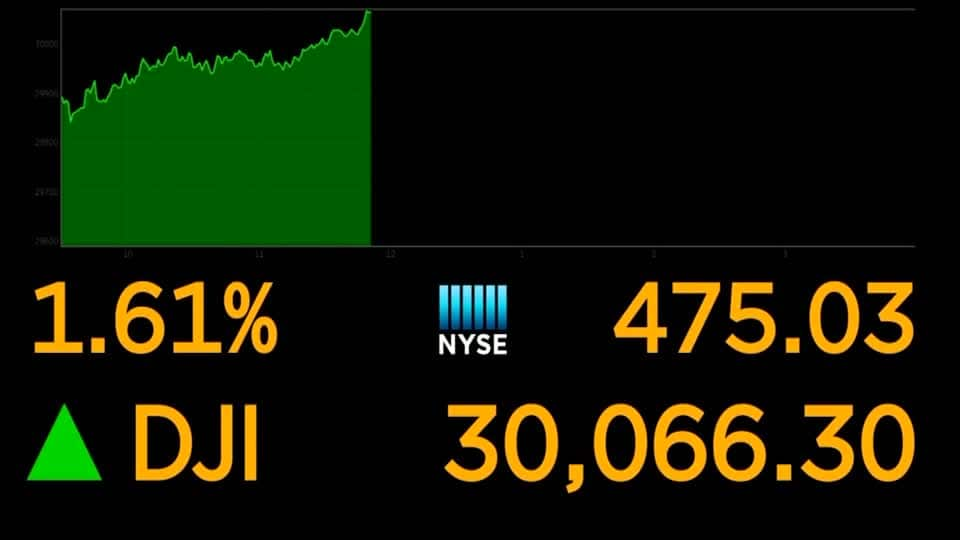Dow closes above 30,000 for the first time

President Trump lauded the Dow’s historic rise Tuesday during a brief appearance at the White House.
“The stock market’s just broken 30,000 — never been broken, that number,” he said. He went on to congratulate his administration and the American people, “because there are no people like you,” before swiftly leaving the lectern.
On Monday, nearly three weeks after the election, the head of the General Services Administration, Emily Murphy, formally notified Biden that the transfer of power could begin. Trump later tweeted his approval of the process but didn’t concede.
The start of the long-delayed transition process appeared to rally investors’ confidence. The move allows the incoming Biden administration to access public funds, plug into security briefings and access the expertise of the federal bureaucracy.
Investors also appeared to approve of Biden’s treasury nominee, Janet L. Yellen, who had served as the chair of the Federal Reserve from 2014 to 2018, leading the agency during the Obama and Trump administrations.
A renowned economist, Yellen, 74, helped the nation recover from the Great Recession. She was a professor before taking on top roles at the Fed, eventually becoming the first woman to lead the central bank. If confirmed by the Senate, she will become the first woman to helm the Treasury Department.
Investors are also encouraged by Yellen’s stance on further stimulus aid. Yellen, echoing the leaders of the Fed, has urged Congress to pass additional emergency funding. During a Bloomberg Television interview in October, she said, “While the pandemic is still seriously affecting the economy, we need to continue extraordinary fiscal support.” She’s also praised other governments that have taken a more aggressive approach to containing the virus.
November’s rally — which lifted the Dow to double-digit growth — also was fueled by multiple breakthroughs in the development of a coronavirus vaccine. On Monday, AstraZeneca became the third pharmaceutical company to announce positive results from late-stage trials of such a vaccine, saying that its candidate, developed by Oxford University, was “highly effective.”
The AstraZeneca candidate was 70 percent effective on average, with as much as 90 percent efficacy in a smaller group that got a lower dosage. Pfizer and its German partner BioNTech, as well as Moderna, have each reported vaccines that were 95 percent effective in clinical trials. By comparison, in years when the flu vaccine is a good match for the strain in circulation, effectiveness ranges from 40 to 60 percent.
But even as some of the most badly beaten stocks continue to build momentum and hopes for an end to the pandemic move closer to medical reality, many companies remain well below their prices before the coronavirus took hold of the country. Health experts have warned that the winter months could bring another escalation of cases, and investors are bracing for further business disruptions.
On Monday, public health officials reported 154,656 new infections, extending a record high seven-day average of new cases. Hospitalizations, too, have never been higher, with more than 85,000 coronavirus patients admitted, a 17 percent jump over the past week. Daily fatalities increased by more than 30 percent.
James McDonald, chief executive of Hercules Investments, said investors should brace for more volatility despite the market’s historic surge Tuesday. He expects cities and states to initiate more restrictions in the coming weeks in response to surging coronavirus cases, as well as congressional tension over fiscal stimulus.
“While Dow 30,000 is a symbolic moment for the stock market, it is simply a continuation of the market’s euphoria after the pre-election sell-off,” McDonald said in a statement emailed to The Washington Post.
The institutional certainty of the political process distracted investors from Wall Street’s higher-risk alternatives. Gold, usually a haven for investors in uncertain times, fell 1.7 percent to $1,806 per ounce. But the yield on the 10-year U.S. Treasury note soared higher, past 2.9 percent. Bond yields rise as prices drop.
Oil markets soared Tuesday, despite the pending risk of shutdowns. By 4 p.m., West Texas intermediate crude, the U.S. oil benchmark, swelled nearly 4.3 percent, to $44.89 per barrel. Brent crude, the international oil benchmark, jumped 4 percent, to $47.89 per barrel.
European indexes also turned green even as several countries struggled to curb coronavirus infections through lockdowns. Germany’s DAX and France’s CAC 40 gained nearly 1.2 percent, while the benchmark Stoxx 600 edged up 0.9 percent.






